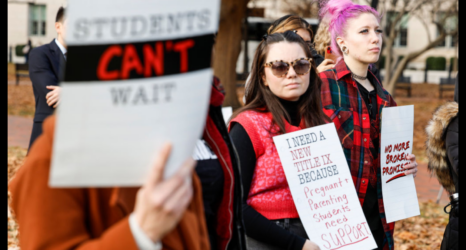In my former life as a high school social studies teacher, one of my favorite courses was U.S. History, which allowed teachers a wide berth in planning lessons. While some would take a few weeks dissecting all the Civil War battles, I would be the only one giving a lesson on the Redstockings Manifesto. I couldn’t help it: My feminist identity bled into my lectures and activities, and for the most part my students were into it. Helping them identify their various privileges (and for some, introducing them to the concept of privilege for the first time) was just as important as ensuring they remembered the preamble to the Constitution (which, thanks to Schoolhouse Rock, most of my students memorized within a day).
So when I come across feminists involved in education in one form or another, I feel hopeful. What better way to procure equality and fairness then by ensuring our youth learn to question and challenge the status quo? With the new school year upon us, it felt only natural to turn the Femisphere spotlight on some standouts in the field of education blogging.
Name: Michelle
Age: 27
Location: St. Louis
Blog: Balancing Jane
Blogging since: April 2010
Find her tweeting: @BalancingJane
When not blogging: Community college English instructor
Favorite subject in school: English/Literature
How did you start blogging about education/teaching? I started blogging when I found out I was pregnant with my daughter. My blog focuses on the intersections between the different parts of my identity: mother, wife, feminist, educator, Ph.D. student. As a student and teacher, education informs those roles in major ways.
What are your thoughts on the teacher’s strike in Chicago? As a parent in an urban Midwest city, I greatly empathize with the problems that all those involved in the Chicago crisis faced. I truly believe that almost everyone involved had the students’ interests in mind, but I cannot believe that standardized testing and crowded classrooms are the answers to those problems. Continuing to put regulations on a broken system makes it impossible for teachers to do their jobs and distracts from the systemic issues underlying these problems, not just in Chicago but across the country. I regret that so many students and their parents were in limbo, but I think that the action of the Chicago teachers was warranted.
Do you feel that feminism has a place in the classroom? Absolutely, both directly and indirectly. My entire pedagogical philosophy is underpinned by my belief in equality, the same belief that frames my feminism. As a developmental writing instructor, I see myself as someone who can help students effectively harness their own voices in ways that empower them and allow them to address the inequities they personally experience and see in the world around them.
Feminism also has a place in the classroom more directly. As an instructor of rhetoric, I teach students to be critical consumers of the messages they receive. A large part of that is examining messages for privilege and bias, and you cannot discuss those systems without addressing feminism.
How can we engage students in feminism?
I’ve found the most effective way is to challenge them to view the world through new perspectives. Students are active participants in the society around them and frequent consumers of media—media often created out of patriarchal power. Showing them that same media through a new lens opens their eyes and challenges them to see their role in that consumption in a new way. Once they start asking the right questions, their engagement in feminism is more organic, something they find for themselves.
Post Pride:
At the Intersections of Teaching and Parenting: It’s Not About Us
On Short Shorts, Black Vernacular English and my Role as an Educator: Discussions from the Intersections
Do What You Love, Love What You Do: Chasing the Carrot and Education
Name: Tressie McMillan Cottom
Age: 33
Location: Atlanta
Blog: www.tressiemc.com
Blogging since: 2003
Find her tweeting: @tressiemcphd
Occupation: Ph.D. student and researcher
Favorite subject in school: Everything but geometry
How did you start blogging about education/teaching? I really began blogging about my life and the many things that inspire me to think. It became evident that much of what inspires me happens to be education. When I started working on my Ph.D. I focused on education as a research interest. Blogging about education and my experiences as a learner and a instructor helps me refine my thinking about my research.
What are your thoughts on the teacher’s strike in Chicago? Someone else said it best: teachers work conditions are students’ learning conditions. In many parts of this country, educators cannot bargain collectively to improve the learning conditions of students. I applaud the Chicago educators for doing what many cannot do.
Do you feel that feminism has a place in the classroom? If you accept that feminism is fundamentally a vision of a world where women are people who exist, how could a classroom not be a place for feminism? If we teach that apes are primates and do not teach that women are humans then we are not effectively educating. Making visible the existence of women as a normal part of any curriculum is only radical if we think girls should be seen and not heard. I do not believe that.
How can we engage students in feminism? First by engaging ourselves in feminism. Modeling is an effective pedagogical tool. When we embrace the idea of women as sentient beings with agency who contribute to our social world then it is impossible to not model that for students. From engaging young girls as leaders to introducing women thinkers, scientists and writers, it all begins with the educators.
Post Pride:
My response to Anne Marie Slaughter’s “Having It All” article: Trickle Down Feminism.
Women, power, and blogging.
My article about for-profit colleges.
Name: Ileana Jiménez
Age: 37
Location: New York, NY
Blog: Feminist Teacher
Blogging since: 2009
Twitter: @feministteacher
Occupation: high school English teacher
Favorite subject in school: English
How did you start blogging about education/teaching? I kept seeing a tremendous gap in the conversation regarding the teaching of women’s, queer and ethnic studies. There was an aching silence that left high schools out of the equation. Most people in higher education see these fields as solely the purview of college classrooms. But I wanted to show how this work could also be done and is being done in high schools. My blog Feminist Teacher both documents the academic and activist work I do with high school students on issues of gender, racial and economic justice as well as provides a platform for other K-12 teachers to bring that work to their own classrooms.
What are your thoughts on the teacher’s strike in Chicago?
For the past few years, teachers have suffered increasing attacks against our profession. Underneath it all, there are two critiques about teachers: First, teachers are not seen as thought leaders or as intellectuals, so there is this constant call for “high quality teachers” that makes current teachers seem as though they are not smart and or prepared enough to be in the classroom; and second, since teaching is not seen as innovative and hard work, we are not compensated for our labor in ways that acknowledge the hours we put in, the intellectual engagement we provide or the emotional support and care we give students every day.
The other part of this conversation is the fact that our profession is highly gendered. Most teachers in K-12 settings are women, so if we are already being depicted as dumb and not important to our larger culture, then it’s pretty easy to accuse us of being recalcitrant teachers who have the gall to ask for fair compensation and better working conditions. But nothing could be farther from the truth. The teachers’ strike was a resounding call to be treated as professionals and as public intellectuals who deserve conditions and compensation that acknowledges the important work we do for our students.
Do you feel that feminism has a place in the classroom?
Feminism definitely has a place in the classroom. The theory of intersectionality alone, which so much of social justice feminism relies on, provides students with the language to understand not only their own daily lived experiences such as racism, sexism, classism, homophobia, transphobia and xenophobia, but also the larger institutional oppressions they witness in their communities, schools, healthcare system, politics and media. Once students have these tools, they are able to take on the issues that matter to them most, such as street harassment, rape and assault, reproductive rights, immigrant rights, queer rights, the sexualization of women and girls and much more. That tool alone gives them the platform with which to make change within themselves, their peers and their larger communities. The ripple effect is huge since they take those tools with them to college and beyond.
How can we engage students in feminism?
Engaging young people in feminism has to be done through issues that matter to them most. I find that my students really learn that their voices matter when they can do something that’s hands-on activism, such as testifying at last year’s New York City council hearing on street harassment with Hollaback! or protesting against photoshopping images of girls in Teen Vogue with SPARK or fighting against the commercial sexual exploitation of children with GEMS (Girls Educational & Mentoring Services). My feminism class has given students an amazing range of activist opportunities that allows them not just to become engaged but to see how they can become committed citizens who care about changing their communities and the larger culture for the better.
Post Pride:
My recent appearance on the Melissa Harris-Perry show
Moving From Theory to Action: Teaching Feminism in High School
Teaching Boys Feminism.
Get schooled in other feminist-minded education-related blogs/sites (and share your favorites in the comments below!):
Bending Toward The Sun–This Tumblr, powered by Emily Heroy, includes original writing and selections from others, all focused on “social justice education, feminism and books.”
F to the Third Power–a blog powered by the high school students in Ileana Jiménez’s class.
Mike Rose–While not explicitly feminist, Rose’s blog includes a lot of great insight on education and equality.
Safe Schools Action Network–A “nationwide grassroots organization committed to empowering all students, educators and communities in building inclusive safe schools and resources©”
Small Strokes Big Oaks–Written by teacher Ashley Lauren, Small Strokes takes on a host of topics, but education is at the center of many posts, which are written from a feminist perspective.
Teaching Tolerance–Another not explicitly feminist site (and magazine) that nonetheless shares many feminist ideals. Teaching Tolerance is “dedicated to reducing prejudice, improving intergroup relations and supporting equitable school experiences for our nation’s children.”
Photos courtesy of the bloggers





